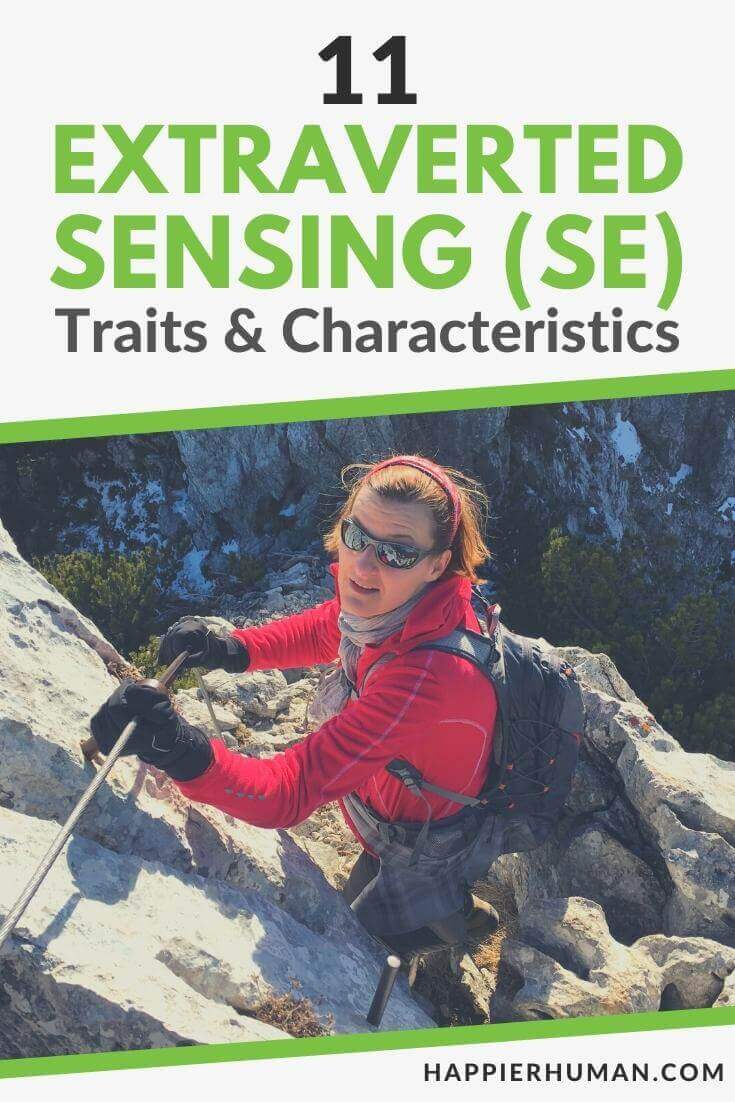There might be affiliate links on this page, which means we get a small commission of anything you buy. As an Amazon Associate we earn from qualifying purchases. Please do your own research before making any online purchase.
Have you ever noticed how individuals respond and interact with the world differently? Personality types, strengths, and preferences influence how we view, interact with, and experience the world.
The Myers-Briggs Type Indicator (MBTI) suggests there are 16 personality types, as explained in more detail in Myers-Briggs 16 Personality Types: A Beginner’s Guide.
They include ISTJ, INTJ, ISFJ, INFJ types. Each has either Extraverted Sensing (Se) or Introverted Sensing (Si) as their dominant or preferred way of gathering and using data in their daily life.
Don’t worry if some of the terms sound foreign to you. They did to me once as well, until I did a bit or research. So to save you time, today I’ll define extraverted sensing. Next, I’ll explain how it differs from introverted sensing before moving on to 11 traits found in those who prefer extraverted sensing – also called Se users.
I’ve also included a link for you to take a Myers-Briggs-based personality test online. You’re a Se user if your personality type is ESTP, ESFP, ISFP, ISTP, ENTJ, ENFJ, INTJ, or INFJ.
What Is Extraverted Sensing?
Sensing (S) is one of the eight psychological functions proposed by the Myers & Briggs personality theory. Intuition (N) is the opposite of sensing. Extraverted sensing is a perceiving function that represents how Si users prefer to take in information about their external environment.
Si users are highly in-tuned with their senses and give more attention to what they learn through touch, sight, hearing, taste, and smell. They are more hands-on and interact with people and situations with an immense level of eagerness.
Extroverted Sensing Thinking Perceiving (ESTP) and Extroverted Sensing Feeling Perceiving (ESFP) personality types are the primary users of Se. The ISFP and ISTP also use it, but only secondary to their feeling and thinking functions.
Differences between Se and Si Users
The main difference is in the perceiving function. See what I mean here:
Extraverted Sensors
Se users are more objective and want to use their five primary senses, touch, sight, hearing, taste, and smell, to experience life instead of relying on memory. They observe, absorb information, and react.
Users with this preference rely on current, objective, and concrete data to make decisions. They typically filter out data from past experiences and potential future consequences. They’re able to stick to what’s current, important, and relevant by doing this.
They typically won’t remember details they perceive as irrelevant information since they aren’t internalizing sensory data.
Introverted Sensors
On the other hand, Si users live in their heads. They internalize or “introvert” sensory data. You’ll notice they rely more on memory and internal sensations such as pain, muscle tension, hunger, and thirst.
They tend to make decisions more on info gathered from past experiences. Doing so requires them to continuously take in and store information for future use. Like a sponge, they soak up details, which comes in useful for accomplishing detailed-oriented tasks.

Dominant users of Si, such as ISTJ and ISFJ, look for patterns and do a lot of linking, comparing, and judgment before acting. This makes them suitable for roles that require a lot of analytical skills. Their sensing tends to activate when something looks different than normal or feels “off.”
Note that extraverted sensing (Se-dominant) is different from extraverted intuition (Ne-dominant), as you may discover from taking the Myer-Briggs personality type test.
Myer-Briggs Personality Types
Earlier on, I mentioned INTJ, ESTP, and other acronyms. Those are the abbreviated names for personality types based on the Myers-Briggs Type Indicator (MBTI). A person can be one of 16 types, according to the MBTI.
The MBTI inventory is designed as a self-report test for identifying your personality type, strengths, and preferences. Four pairs of psychological preferences/scales make up each personality type, as indicated below:
Each preference is valuable in itself, yet they all complement each other. Test your personality for FREE and get feedback on whether you’re Se-dominant. I took the test. Turns out, I have an Introverted Sensing Thinking Judging (ISTJ) personality type.
As an ISTJ, I use Introverted Sensing (Si) as my dominant function. Hillary Clinton and Barack Obama are among 43 Famous People & Celebrities with ISTJ Personality Type.
MBTI-based tests help you understand yourself (and others), which can help improve communication, relationships, as well as your chances for happiness.
11 Traits and Characteristics Seen in Extraverted Sensors
Below are 11 signs to help determine if you or someone close to you live life through extraverted sensing. Of the eight types of Se users, the characteristics are most noticeable in ESTP and ESFP personality types. The two use Se as their primary way of absorbing information.
Trait #1. Live in the present
More focused on actual, present, current, and real is how Myer-Briggs describe extraverted sensors. Their focus is on living in the now. What’s present and real is far more appealing, not imagination or possibilities. They achieve this by narrowing down to only what is real to their senses.
The present is certain, and certainty minimizes stress and anxiety. Future events are not of much use to them as current enjoyments. Therefore, don’t expect to find them daydreaming about an upcoming concert even if their favorite artiste is performing.
Trait #2. Open-minded
Extraverted sensors are the type of people you can feel comfortable having discussions with, knowing that they’ll listen to your views. Because of their open-mindedness, they are less likely to judge or criticize. They’re going to share their own opinions and are perfectly fine if yours don’t match theirs.
You’ll also know they’re Se users once you realize they don’t impose their worldview on you or force you to side with them. Now, they will hold steadfast to their personal convictions. Even then, they will try to see and acknowledge your point of view.
Trait #3. Quick reflexes
Se-dominant personalities don’t walk around with their heads in the clouds. They’re connected to the physical world and are in tune with their surroundings. They keep unconsciously scanning the perimeters for real-time information. They notice little details due to the heightened use of their senses.

Their quick reflexes come from a heightened awareness of what’s happening. This lets them quickly grasp opportunities, react to threatening situations, and avoid danger others may not notice until it’s too late.
Trait #4. Energized by the external world
If you’re a Se user, your joy comes from interacting with people, nature, and learning cultures. The sights, smells, sounds, and feelings you get from your external world stimulate you. Adventures and outdoor activities spark interest and enthusiasm.
No wonder you’re always on the go. You’ll pick up on little environmental nuances like the scents of flowers, sirens in the distance, and the tweeting of birds. Those things aren’t a nuisance, since you enjoy immersing yourself in your external surroundings.
Trait #5. Don’t dwell on the past
For those with dominant Se function, once something happens, it’s done and gone. They’re ready to move on and direct their focus and energy to something new. They don’t mope about all the fun stuff they missed by not attending a party.
What’s present, real, and practical and the element of surprise of what could happen next is far more stimulating. Of course, they rely on memory and past events, but only as far as the details add context and depth to the present.
Trait #6. Spot details others miss
You might have Se psychological preference if you’re surprised whenever people around you fail to notice things that are right in their faces. You take in detailed information about current affairs, people, places, and things.
That information is stored and can quickly be retrieved from your memory bank as the situation requires. The next time you’re tempted to get impatient with someone you think should’ve noticed particular details, remember extraverted sensing may not be a part of their personality makeup.
Trait #7. Live on the “edge”
To enjoy things that are new, different, or unknown, people with Se capabilities may have to take risks. They’re not afraid to live on the edge of the unknown if that means a chance for thrills and excitement. Thrill-seeking activities include mountain climbing and skydiving.
They’ll even come with an open mind and eagerness to learn something new. Their spontaneous and risk-taking attitude enables them to have rich and more diverse life experiences. They’ll consider the risks but won’t necessarily pass up an opportunity for pleasure because others are afraid.
Trait #8. Inductive thinkers
Extraverted Sensors naturally use inductive thinking or bottom-up reasoning to get answers and make conclusions.
They rely on information and ideas that are factual, practical, and grounded in reality instead of those that are abstract. Remember they have to be able to see, touch, feel, smell, or hear to accept it’s real.
They’ll use a body of information, such as observations and experiences, to arrive at a general idea. It’s the opposite of a deductive or top-to-bottom thinker who starts with general ideas and logically works their way down to specific conclusions.
Trait #9. Fond of children and animals
Se types are people persons and animal lovers. The spontaneity and happy-go-lucky nature of children and animals attract extraverted sensors. After all, they’re outgoing, playful, and fun-loving by nature.

They’re going to think twice or be timid about interacting with kids. Expect them to jump right in and unleash their own inner child, as they get down to playtime. They derive sheer joy and excitement from such experiences.
Trait #10. Eager to listen to people’s life stories
Someone who has an extraverted sensing function is always curious about people. That’s because they are naturally sociable beings and care about others and their personal experiences. They’ll stop and listen attentively, whether it’s their partner, friend, co-worker, children, or a stranger.
You can tell them about your job, family life, or a current stressor. Talking to them makes you feel like you’re talking to an old pal even if you’re a perfect stranger. Like empaths, they simply have the ability to make people feel seen and heard.
Trait #11. Make decisions quickly
Personalities with primary Se function are able to quickly process a problem and find solutions. Remember they aren’t “heady” like introverted sensors that overthink and overanalyze details before making a move. Their quick decision-making skills stem from being less prone to planning and more action-oriented.
ESTPs, for example, are “quintessential doers,” according to the article, An Overview of the ESTP Personality Type. Having a quick decision-making ability makes them good bosses and leaders. They’ll improvise and take risks if they have to in order to get the job done.
Final Thoughts on Extraverted Sensing (Se) Characteristics
Everyone has a different way of thinking, doing things, and interacting in their day-to-day life. People who rely primarily on extraverted sensing are likely to exhibit the 11 characteristics here – more than those who are second, third, or fourth users of Se.
They are ISFP and ISTP (secondary), ENTJ and ENFJ (tertiary), and INTJ and INFJ (inferior) respectively. Still curious about your personality and how this all comes into play? Then check out our article on the 11 Best Online Personality Tests to Learn about Yourself.
Finally, if you want to identify YOUR personality type, then take one of these 11 personality tests to better understand what makes you tick.


